Introduction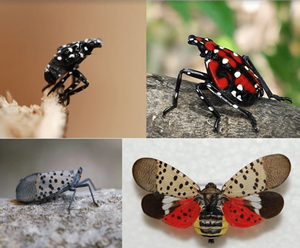
Spotted lanternfly, is an invasive planthopper, native to Asia, that was first detected in southeastern Pennsylvania in 2014. It feeds on many plants, including economically important crops like grapevines and ornamentals.
Identification and Life Cycle
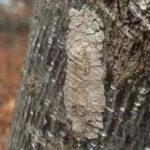 There is one generation of Spotted Lanternfly per year. The eggs are laid in the fall and hatch in the spring. Egg masses are laid on hard surfaces (trees, decks, houses, outdoor equipment, rocks, etc.) and protected with a mud-like covering. Each egg mass contains 30–50 eggs. After hatching and before reaching adulthood, Spotted Lanternfly goes through four nymphal stages.
There is one generation of Spotted Lanternfly per year. The eggs are laid in the fall and hatch in the spring. Egg masses are laid on hard surfaces (trees, decks, houses, outdoor equipment, rocks, etc.) and protected with a mud-like covering. Each egg mass contains 30–50 eggs. After hatching and before reaching adulthood, Spotted Lanternfly goes through four nymphal stages.
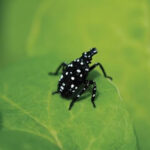 Nymphs are small (⅛ to ½ inch) and can be hard to find. The first three stages (instars) are all black with white spots, and the last instar is red with white dots and black stripes. Spotted Lanternfly adults emerge in July and are active until winter. This is the most obvious and easily detectable stage because they are large (~1 inch) and
Nymphs are small (⅛ to ½ inch) and can be hard to find. The first three stages (instars) are all black with white spots, and the last instar is red with white dots and black stripes. Spotted Lanternfly adults emerge in July and are active until winter. This is the most obvious and easily detectable stage because they are large (~1 inch) and 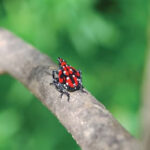 highly mobile. Adults have black bodies with brightly colored wings. Only the adults can fly. Spotted Lanternfly wings remain closed while they are feeding and walking. Spotted Lanternfly wings are gray with black spots, and the tips of the wings are black with gray veins.
highly mobile. Adults have black bodies with brightly colored wings. Only the adults can fly. Spotted Lanternfly wings remain closed while they are feeding and walking. Spotted Lanternfly wings are gray with black spots, and the tips of the wings are black with gray veins.
Quick Facts
- Spotted Lanternfly is a destructive invasive pest threatening agricultural and ornamental plants.
- As of May 2020, 26 counties in Pennsylvania are under quarantine for Spotted Lanternfly.
- Spotted Lanternfly has also been found in 5 other states in the northeastern U.S.
- Spotted Lanternfly does not bite or sting.
- Spotted Lanternfly does not kill all trees it feeds on.
- Spotted Lanternfly is a plant stressor that, along with other stressors, can cause significant damage to its host.
- Manage Spotted Lanternfly on your property by scraping and destroying eggs, carefully using bands or traps on trees, removing preferred hosts, and using registered insecticides for control when appropriate.
Seasonal studies of recurrence
Spotted Lanternfly has a broad host range and has been recorded feeding on over 65 different plant species. Despite this broad host range, some plants appear to be more favorable to Spotted Lanternfly than others. Numerous variables appear to determine the attractiveness of a particular plant, including what other plants species are available in the nearby landscape, the health of the plant, the time of year, the Spotted Lanternfly population size, and how long Spotted Lanternfly has been present in the area. Nymphs, in particular, seem to have an especially large host range, whereas adults seem to depend more on certain hosts.
Feeding Damage
Spotted Lanternfly is capable of causing serious damage to host plants, including oozing sap from the trees, wilting, leaf curling, and tree dieback. Spotted Lanternfly feeds using a piercing-sucking mouthpart tapped into the plant like a straw. When Spotted Lanternfly feeds, it excretes honeydew, a sugar-rich liquid waste product.
Honeydew serves as a substrate for sooty mold, fungi that thrive in sugary environments. Spotted Lanternfly expels significant amounts of honeydew, and often the plant surface and the area around infested plants to be found on these hosts. Plants are less likely to serve as hosts for Spotted Lanternfly as they begin to deteriorate at the end of the growing season. The patterns in host use may change with varying weather conditions, region, and other undetermined factors.
Spotted Lanternfly feeding cycle
Nymphs – May, June & July
Adults – August, September & October



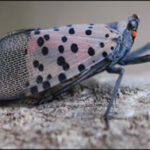
Key plant hosts of Spotted Lanternfly throughout the growing season.
- Rose (cultivated, multi-flora)
- Grape (wild and cultivated)
- Tree-of-heaven
- Black walnut, butternut
- River birch
- Willow
- Sumac
- Silver/red maple
Management
Management efforts are targeted at multiple life stages of the Spotted Lanternfly. Egg masses can be scraped off of surfaces where they are found. Brown sticky bands are effective in catching nymphs on trees. Adults are controlled using a combination of Ailanthus host reduction and the establishment of trap trees treated with systemic insecticide, which has shown to be capable of removing significant numbers of adults in the population.
Courtesy: Penn State Extension in collaboration with the Pennsylvania Department of Agriculture and the United States Department of Agriculture.